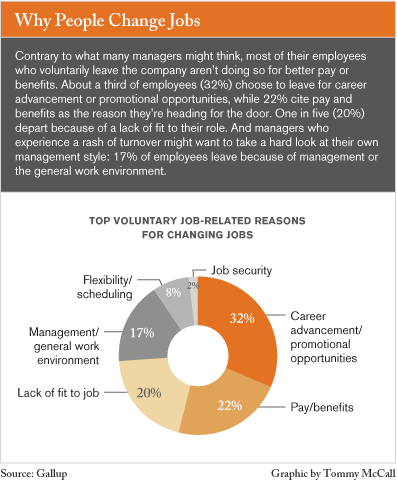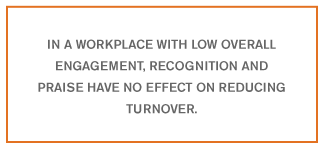Anna recently quit her job. She had held the same job for 19 years and never registered a complaint, so her resignation came as quite a shock to her manager. It shouldn't have. Turnover can be predictable if you know what to look for.
 |
"When I turned in my letter, [the manager] said he was surprised and wanted to know what it would take to make me stay," says Anna. "I said that the working conditions were not conducive to effective performance, because I couldn't say the truth -- that he made us all miserable. So two days later, he comes back with a new offer. I could have more money or fewer hours, but nothing else was any different. It's still the same toxic atmosphere."
Unfortunately, this is a common problem -- and a common management response. According to Gallup research, which included a meta-analysis of 44 organizations and 10,609 business units, Gallup Polls of the U.S. working population, exit interviews conducted on behalf of several companies, and Gallup's selection research database, most people quit for a few explainable reasons. What's more, a set of engagement elements explains 96% of the attitudes that drive voluntary turnover rates for work units. But the reasons people leave might not be what most bosses think.
Money can't buy love -- or loyalty
According to James K. Harter, Ph.D., Gallup's chief scientist for workplace management, people leave companies because of factors that filter through the local work environment. At least 75% of the reasons for voluntary turnover can be influenced by managers. Still, many bosses think -- like Anna's does -- that all turnover comes down to money.
Money is important, but it doesn't buy employee loyalty. Gallup conducted two polls in 2006 regarding turnover. Of those who quit their jobs, 82.8% left their companies, while 17.2% moved to a new position in the same company. When those who quit voluntarily were asked why they quit, "pay and benefits" was the second most common answer, but only 22.4% of respondents mentioned it.
 |
Pay can seem adequate to engaged employees and an insult to actively disengaged workers, even when the pay rate is essentially the same. The polls found that the median pay for all nonmanagerial respondents was between $25,000 and $35,000. When asked if their pay, from an objective viewpoint, was appropriate for the work they do, 42.9% of engaged workers said it was, compared to 15.2% of not engaged workers and 13% of actively disengaged employees.
The most common answer respondents gave for why they were moving on was for career advancement or promotional opportunities (31.5%), while 20.2% said they lacked job fit. And 16.5% said they were leaving, like Anna did, because of management or the general work environment. Much smaller percentages quit because of flexibility or scheduling (7.7%) or job security (1.7%). (See graphic "Why People Change Jobs.")
Notice a pattern? Most of the reasons employees cited for their turnover are things that managers can influence. And managers who can't or won't alter the factors that drive turnover can expect to be writing help-wanted ads in the near future. But there are additional ways to predict turnover in a business unit.
Where there's smoke . . .
Work units with high potential for turnover send up signal flares, but you have to know where to look to see them. According to Gallup research, if the people in a work unit say their manager's expectations are unclear; that the manager provides inadequate equipment, materials, or resources; and that the opportunities for progress and development are scanty, there will be trouble. There are other indicators too. Workers in roiling departments often say they don't fit their job, that their coworkers aren't committed to quality, that their pay and benefits are bad, and that they aren't connected to the purpose of the organization or to senior management. (See graphic "The Top Five Predictors of Turnover.")
The Top Five Predictors of TurnoverWork units with high potential for turnover send out warning signals, according to Gallup research, but managers and executives must know where to look: 1. The immediate manager. If employees report that their manager's expectations are unclear; or that their manager provides inadequate equipment, materials, or resources; or that opportunities for progress and development are few and far between, watch out: Trouble is on the way. 2. Poor fit to the job. Another sign of trouble appears when employees perceive that they don't have opportunities to do what they do best every day. 3. Coworkers not committed to quality. Watch for employees who perceive that their coworkers are not committed to a high standard of work. 4. Pay and benefits. Engaged employees are far more likely to perceive that they are paid appropriately for the work they do (43%), compared to employees who are disengaged (15%) or actively disengaged (13%). And pay and benefits become a big issue if employees feel that their coworkers aren't committed to quality; they may feel entitled to extra compensation to make up the difference or to make them feel like they are truly valued by their employer. 5. Connection to the organization or to senior management. Another key sign that turnover may be looming appears when employees don't feel a connection to the organization's mission or purpose or its leadership. Source: Gallup research, including meta-analysis, employee opinion polls, and exit interview studies conducted over the past 30 years |
Interestingly, pay and benefits are a bigger issue if workers feel that their coworkers aren't committed to quality. "Inequity in effort likely drives greater emphasis on pay as a determinant of perceived value," says Harter, who coauthored 12: The Elements of Great Managing. In other words, people who believe that their coworkers aren't doing their share of the work may feel entitled to extra compensation to make up the difference or to make them feel like they are valued by their employer.
Harter's research team discovered that a worker's responses to the items on Gallup's Q12 employee engagement survey explain at least 96% of the meta-analytic relationship between teams' overall satisfaction with their company and later turnover rates for the same teams. The research shows that an employee's attitude about the workplace is important and predictive of turnover. But it's possible for employees to report high levels of engagement and still quit -- or feel actively disengaged and stay -- depending on the way the engagement elements interact.
According to Gallup's research, 9 of the 12 workplace elements consistently predict turnover across business units, regardless of an organization's size. These elements are: having clear expectations, having the materials and equipment to do the job right, having the opportunity to do what you do best every day, the belief that someone at work cares, the belief that someone encourages your development, a sense that your opinions count, the mission or purpose of the company making you feel that your job is important, a belief that your coworkers are committed to quality, and having opportunities to learn and grow at work. If these needs are met, as shown by higher scores on these employee engagement items, turnover is likely to be low. If not, keeping people may be the hardest part of a manager's job.
When it comes to predicting turnover, the remaining three Q12 elements come into play depending on the overall engagement of the workplace. In workplaces where engagement levels are high, those three elements -- recognition, progress discussions, and the presence of a best friend at work -- add significant value, and turnover is much less likely. But in workplaces where engagement is low, high scores on those three elements don't have much effect on keeping people. "I think this is because the overall culture supports or contradicts the local culture when it comes to feedback systems," says Harter. "When there is a contradiction between local and broad culture, people sense a lack of authenticity."
For instance, in a workplace with low overall engagement, recognition and praise have no effect on reducing turnover. But in a company with moderate to strong engagement levels, teams that report they receive adequate recognition have 19% less turnover than teams that say they don't receive enough recognition. "It's likely that employees perceive recognition as authentic when the overall culture is supportive -- and inauthentic or even confusing when the culture is miserable," says Harter.
 |
The research revealed a similar pattern when it comes to discussions about an employee's progress. In low-engagement workplaces, these discussions don't have much effect on turnover. But in moderately to highly engaged workplaces, teams with employees who report they have discussed their progress with their manager in the past six months also report 19% less turnover. Harter says this is probably because "In cultures where engagement is low, progress discussions turn into performance evaluations. But when the team is engaged, progress discussions actually do what they're meant to do: help an employee to progress."
The Q12 element "I have a best friend at work" can have a particularly important relationship to retention, depending on the quality of the work environment. In a negative culture, best friends may leave together; teams with many best friends have 8% more turnover than those with few friends. In a moderately to highly engaged atmosphere, friends stay together, and turnover is 18% less per year for teams with many best friends, in comparison to those with few best friends.
None of this is a surprise to Anna, the woman who quit her job after 19 years. "The last time someone talked to me about my progress was six or seven years ago, when [the last manager] left," she said. "I'd be scared to death if the [manager] there now wanted to talk to me." The best friends issue hasn't yet applied to Anna; she says most of her best friends are at her old job, and none of them have yet resigned. But praise? "We understood praise to mean continued employment. If you weren't getting fired, you must be doing okay," she says.
Red flags
Employees may choose to work for a company for high-minded or practical reasons. But many opt to work in a role that gives them an opportunity to do their best. Harter's research found that turnover is lower in work units in which the manager adjusts jobs based on individual talents and strengths and actively removes unnecessary barriers. Perhaps it's the opportunity to do what one does best that explains this arresting number: Organizations that select people who psychologically fit their jobs can reap significant gains in retention. In these companies, 20% to 40% fewer managers and skilled or semi-skilled employees quit than in companies that don't select for talent.
That's likely what kept Anna in her job for nearly two decades. Though she says the work environment was awful, her job let her do what she did best to the point that she's renowned for it in her professional circle. "[The manager] doesn't really know what I do," says Anna, "and that probably kept him from telling me what to do. That helped a lot." Ultimately, the negative work environment drove Anna to resign.
One of the best predictors of turnover is whether an employee has had opportunities at work to learn and grow. Harter's research team found a telling fact about people who strongly agree with the Q12 items "There is someone at work who encourages my development," "In the last six months, someone at work has talked to me about my progress," "My supervisor, or someone at work, seems to care about me as a person," and "At work, my opinions seem to count." Workers who strongly agree with these four items were twice as likely to say they have opportunities at work to learn and grow. What's more, 92% say they plan to be with their companies a year later.
The costs of turnover
The U.S. Bureau of Labor Statistics has found that the U.S. voluntary turnover rate is 23.4% annually. It's generally estimated that replacing an employee costs a business one-half to five times that employee's annual salary. So, if 25% of a business' workforce leaves and the average pay is $35,000, it could cost a 100-person firm between $438,000 and $4 million a year to replace employees.
It's going to take a considerable amount of money to replace Anna. "A new person will have to learn the job, prove herself or himself [in the industry], and learn to recognize the subtleties of the job. And that will take time. Meanwhile, the backlog will grow," she says. Anna estimates it will cost her organization $45,000 to $150,000 to replace her, and that money certainly wasn't in the budget.
Not all turnover is bad; new blood is healthy, and new employees can bring fresh ideas to their companies. But losing a valuable employee costs a business in time, money, and stress to other employees. Like all unnecessary blood loss, it should be stemmed whenever possible.
Sadly, too many managers have tied all tourniquets around the wrong limbs, yet they're wondering why their teams keep bleeding. The beauty of Harter's research is that it shows companies where to look for problems. The value of the research is that it gives clues to how those problems can be corrected, if managers have the courage to fix them.